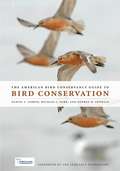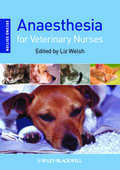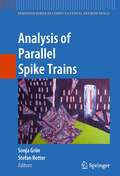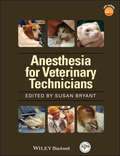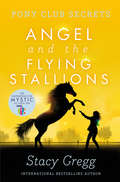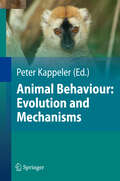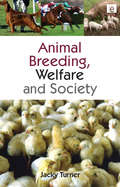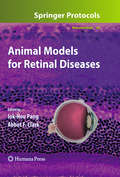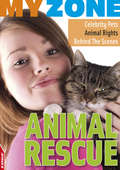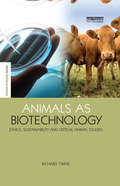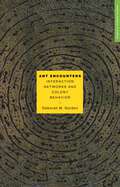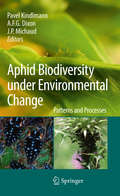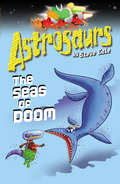- Table View
- List View
The American Bird Conservancy Guide to Bird Conservation
by Daniel J. Lebbin Michael J. Parr George H. FenwickWhether we live in cities, in the suburbs, or in the country, birds are ubiquitous features of daily life, so much so that we often take them for granted. But even the casual observer is aware that birds don’t fill our skies in the number they once did. That awareness has spawned conservation action that has led to notable successes, including the recovery of some of the nation’s most emblematic species, such as the Bald Eagle, Brown Pelican, Whooping Crane, and Peregrine Falcon. Despite this, a third of all American bird species are in trouble—in many cases, they’re in imminent danger of extinction. The most authoritative account ever published of the threats these species face, The American Bird Conservancy Guide to Bird Conservation will be the definitive book on the subject. The Guide presents for the first time anywhere a classification system and threat analysis for bird habitats in the United States, the most thorough and scientifically credible assessment of threats to birds published to date, as well as a new list of birds of conservation concern. Filled with beautiful color illustrations and original range maps, the Guide is a timely, important, and inspiring reference for birders and anyone else interested in conserving North America’s avian fauna. But this book is far more than another shout of crisis. The Guide also lays out a concrete and achievable plan of long-term action to safeguard our country’s rich bird life. Ultimately, it is an argument for hope. Whether you spend your early weekend mornings crouched in silence with binoculars in hand, hoping to check another species off your list, or you’ve never given much thought to bird conservation, you’ll appreciate the visual power and intellectual scope of these pages.
The American Bird Conservancy Guide to Bird Conservation
by Daniel J. Lebbin Michael J. Parr George H. FenwickWhether we live in cities, in the suburbs, or in the country, birds are ubiquitous features of daily life, so much so that we often take them for granted. But even the casual observer is aware that birds don’t fill our skies in the number they once did. That awareness has spawned conservation action that has led to notable successes, including the recovery of some of the nation’s most emblematic species, such as the Bald Eagle, Brown Pelican, Whooping Crane, and Peregrine Falcon. Despite this, a third of all American bird species are in trouble—in many cases, they’re in imminent danger of extinction. The most authoritative account ever published of the threats these species face, The American Bird Conservancy Guide to Bird Conservation will be the definitive book on the subject. The Guide presents for the first time anywhere a classification system and threat analysis for bird habitats in the United States, the most thorough and scientifically credible assessment of threats to birds published to date, as well as a new list of birds of conservation concern. Filled with beautiful color illustrations and original range maps, the Guide is a timely, important, and inspiring reference for birders and anyone else interested in conserving North America’s avian fauna. But this book is far more than another shout of crisis. The Guide also lays out a concrete and achievable plan of long-term action to safeguard our country’s rich bird life. Ultimately, it is an argument for hope. Whether you spend your early weekend mornings crouched in silence with binoculars in hand, hoping to check another species off your list, or you’ve never given much thought to bird conservation, you’ll appreciate the visual power and intellectual scope of these pages.
Anaesthesia for Veterinary Nurses
by Liz WelshAnaesthesia for Veterinary Nurses has been written specifically for veterinary nurses by veterinary nurses and veterinary surgeons. Easy to read and understand, it provides detailed coverage of the physiological, pharmacological and physical aspects of anaesthesia. Fully updated and reflecting recent changes to veterinary nursing qualifications, this second edition is now also illustrated in colour. Sedation and anaesthesia are a crucial part of veterinary practice, and the protocols and methods involved are often complex and vary considerably from animal to animal. In addition to cats and dogs, Anaesthesia for Veterinary Nurses contains detailed sections on rabbits, rodents, birds, reptiles, and larger animals. Suitable for those with or without previous subject knowledge, this book is ideal for quick reference by veterinary nurses and technicians in practice, or for more substantial study by students. • Reflects recent changes to veterinary nursing qualifications, current terminology and drugs in use. • Includes chapters on small mammals, birds, reptiles, and large animals. • Now illustrated with colour photographs.
Analysis of Parallel Spike Trains (Springer Series in Computational Neuroscience #7)
by Sonja Grün Stefan RotterSolid and transparent data analysis is the most important basis for reliable interpretation of experiments. The technique of parallel spike train recordings using multi-electrode arrangements has been available for many decades now, but only recently gained wide popularity among electro physiologists. Many traditional analysis methods are based on firing rates obtained by trial-averaging, and some of the assumptions for such procedures to work can be ignored without serious consequences. The situation is different for correlation analysis, the result of which may be considerably distorted if certain critical assumptions are violated. The focus of this book is on concepts and methods of correlation analysis (synchrony, patterns, rate covariance), combined with a solid introduction into approaches for single spike trains, which represent the basis of correlations analysis. The book also emphasizes pitfalls and potential wrong interpretations of data due to violations of critical assumptions.
Anesthesia for Veterinary Technicians (Coursesmart Ser.)
by Susan Bryant Cvt VtsAnesthesia for Veterinary Technicians is a highly practical guide to anesthesia skills for veterinary technicians published in association with the Academy of Veterinary Technician Anesthetists (AVTA). Packed with hints and tips to aid technicians in the practice of veterinary anesthesia, the book offers an essential resource to building anesthesia skills and improving knowledge. Encompassing both background knowledge and practical application of anesthesia-related skills, Anesthesia for Veterinary Technicians is a valuable resource for veterinary technicians of all skill levels. Supplementary website materials, including charts and forms for use in the practice, are available at www.wiley.com/go/bryant.
Anesthesia for Veterinary Technicians
by Susan BryantAnesthesia for Veterinary Technicians is a highly practical guide to anesthesia skills for veterinary technicians published in association with the Academy of Veterinary Technician Anesthetists (AVTA). Packed with hints and tips to aid technicians in the practice of veterinary anesthesia, the book offers an essential resource to building anesthesia skills and improving knowledge. Encompassing both background knowledge and practical application of anesthesia-related skills, Anesthesia for Veterinary Technicians is a valuable resource for veterinary technicians of all skill levels. Supplementary website materials, including charts and forms for use in the practice, are available at www.wiley.com/go/bryant.
Angel and the Flying Stallions (Pony Club Secrets #10)
by Stacy GreggThe tenth exciting adventure in the ‘Pony Club Secrets’ series sees Issie travel back to Spain to reclaim her beloved colt, Storm… and learn to ride haute ecole on flying stallion, Angel!
Angel Cats: When feline friends touch hearts and change lives
by Linda Anderson Allen AndersonMeet the cats who acted as a pacemaker when a woman's heart suddenly stopped beating in the night; Paprika, a gentle giant with deep orange stripes who saved a little Hungarian girl from Russian soldiers; Lucky, the kitten who survived against the odds and went on to help deaf children as a therapy cat; Princess the courageous cat who helped a lady make friends in an unpleasant and intimidating work environment; and many others.The extent of a cat's love can be utterly astonishing as these stories of bravery, loyalty and kindness demonstrate. These fascinating creatures are as compassionate as they are curious and will go to extraordinary lengths to nurture and protect their human friends.Angel Cats will win a special place in your heart. . .
Angel Pets: Incredible True Stories of Animal Miracles
by Margrit CoatesMargrit Coates is an internationally acclaimed animal healer and communicator. In Angel Pets, she reveals how animals talk to us all the time and shares their incredible true stories.Meet Rusty, the lost dog whom Margrit guided home using the psychic connection between them; Mitzi, the brave little cat who made the greatest sacrifice; Twinkle, the determined rabbit who saved a girl's life; Gypsy, the sheepdog with special healing powers; Freddy's friend, the demon cat who was really an angel in disguise, and many, many more wonderful animals.Through these amazing stories, Margrit answers the question that every pet owner will have asked themselves: what is my pet really thinking? Offering helpful tips, she unlocks the secret of tuning into and connecting with pets at the very deepest level.A heartwarming read, this book will change the way you relate to animals forever.
Animal Behaviour: Evolution and Mechanisms
by Nils Anthes Ralph Bergmüller Wolf Blanckenhorn H. Jane Brockmann Claudia Fichtel Lutz Fromhage Joachim Frommen Wolfgang Goymann Juergen Heinze Katharina Hirschenhauser Heribert Hofer Sylvia Kaiser Peter M. Kappeler Bart Kempenaers Gerald Kerth Judith Ingrid Korb Kurt M. Kotrschal Cornelila Kraus Martha Manser Nico Michiels Robin F. Moritz Mario Pahl Dustin Penn Norbert Sachser Martin Schaefer Carel P. van Schaik Jutta M. Schneider Isabella Schreiber Michael Taborsky Jürgen Tautz Fritz Trillmich Shaowu ZhangAnimal Breeding, Welfare and Society
by Jacky TurnerThe determination of when, how, how often and with whom an animal breeds is moving rapidly away from evolutionary pressures and towards human purposes: these include the breeding of around 50 billion mammals and birds for food production annually, the breeding of pedigree dogs and cats, racing dogs and horses, specialised laboratory animal strains and the use of reproductive science to conserve endangered species or breeds and to limit unwanted populations of pests and non-native species. But the ethics and sustainability of this takeover of animals' reproductive lives have been insufficiently examined by either professionals or the public. This book discusses the methods, the motivations and the consequences of human intervention in animal breeding in terms of animal health, behaviour and well-being. It explores where we are now and the choices ahead, and looks to a future where we have more respect for animals as sentient beings and where we could loosen the reins of reproductive control.
Animal Breeding, Welfare and Society
by Jacky TurnerThe determination of when, how, how often and with whom an animal breeds is moving rapidly away from evolutionary pressures and towards human purposes: these include the breeding of around 50 billion mammals and birds for food production annually, the breeding of pedigree dogs and cats, racing dogs and horses, specialised laboratory animal strains and the use of reproductive science to conserve endangered species or breeds and to limit unwanted populations of pests and non-native species. But the ethics and sustainability of this takeover of animals' reproductive lives have been insufficiently examined by either professionals or the public. This book discusses the methods, the motivations and the consequences of human intervention in animal breeding in terms of animal health, behaviour and well-being. It explores where we are now and the choices ahead, and looks to a future where we have more respect for animals as sentient beings and where we could loosen the reins of reproductive control.
Animal Models for Retinal Diseases (Neuromethods #46)
by Iok-Hou Pang and Abbot F. ClarkAffecting over a hundred million individuals worldwide, retinal diseases are among the leading causes of irreversible visual impairment and blindness, and appropriate study models, especially animal models, are essential to furthering our understanding of the etiology, pathology, and progression of these endemic diseases. In Animal Models for Retinal Diseases, recognized experts in the field highlight valuable techniques as well as animal models for the prominent retinal diseases in order to aid in the evaluation, development, and improvement of therapeutic strategies. Beginning with an overview of the morphology of the retina, visual behavior, and genetics and genomics approaches for retinal research, the book continues by covering animal models for the research of specific human retinal diseases, e.g., retinal degeneration, age-related macular degeneration, retinopathy of prematurity, diabetic retinopathy, glaucoma, retinal ischemia, and retinal inflammation. As a volume in the successful Neuromethods series, the chapters provide authoritative reviews of the most commonly used approaches in the field. Vital and easy to use, Animal Models for Retinal Diseases serves to support the important future research of ocular investigators, ophthalmologists, and neuroscientists currently delving into this fascinating field of study.
Animal Rescue (EDGE: My Zone #2)
by Anita GaneriMY ZONE is the hottest place to come for news, gossip, facts and stories from scenes that matter to you. Top picks from inside Animal Rescue: - Cruelty-free shopping- At a rescue centre- Animal experiments- Puppy farms- Star pets- Is having a pet OK?- Top ten pets- Star pets- Working with animals- Cheetah rescue- Are zoos cruel or cool?- Animal quizzes- My rescue pet
Animals as Biotechnology: "Ethics, Sustainability and Critical Animal Studies"
by Richard TwineIn Animals as Biotechnology sociologist Richard Twine places the question of human/animal relations at the heart of sustainability and climate change debates. The book is shaped by the emergence of two contradictory trends within our approach to nonhuman animals: the biotechnological turn in animal sciences, which aims to increase the efficiency and profitability of meat and dairy production; and the emerging field of critical animal studies - mostly in the humanities and social sciences - which works to question the nature of our relations with other animals. The first part of the book focuses on ethics, examining critically the dominant paradigms of bioethics and power relations between human and non-human. The second part considers animal biotechnology and political economy, examining commercialisation and regulation. The final part of the book centres on discussions of sustainability, limits and an examination of the prospects for animal ethics if biotechnology becomes part of the dominant agricultural paradigm. Twine concludes by considering whether growing calls to reduce our consumption of meat/dairy products in the face of climate change threats are in fact complicit with an anthropocentric understanding of sustainability and that what is needed is a more fundamental ethical and political questioning of relations and distinctions between humans, animals and nature.
Animals as Biotechnology: "Ethics, Sustainability and Critical Animal Studies"
by Richard TwineIn Animals as Biotechnology sociologist Richard Twine places the question of human/animal relations at the heart of sustainability and climate change debates. The book is shaped by the emergence of two contradictory trends within our approach to nonhuman animals: the biotechnological turn in animal sciences, which aims to increase the efficiency and profitability of meat and dairy production; and the emerging field of critical animal studies - mostly in the humanities and social sciences - which works to question the nature of our relations with other animals. The first part of the book focuses on ethics, examining critically the dominant paradigms of bioethics and power relations between human and non-human. The second part considers animal biotechnology and political economy, examining commercialisation and regulation. The final part of the book centres on discussions of sustainability, limits and an examination of the prospects for animal ethics if biotechnology becomes part of the dominant agricultural paradigm. Twine concludes by considering whether growing calls to reduce our consumption of meat/dairy products in the face of climate change threats are in fact complicit with an anthropocentric understanding of sustainability and that what is needed is a more fundamental ethical and political questioning of relations and distinctions between humans, animals and nature.
Ant Encounters: Interaction Networks and Colony Behavior
by Deborah M. GordonHow do ant colonies get anything done, when no one is in charge? An ant colony operates without a central control or hierarchy, and no ant directs another. Instead, ants decide what to do based on the rate, rhythm, and pattern of individual encounters and interactions--resulting in a dynamic network that coordinates the functions of the colony. Ant Encounters provides a revealing and accessible look into ant behavior from this complex systems perspective. Focusing on the moment-to-moment behavior of ant colonies, Deborah Gordon investigates the role of interaction networks in regulating colony behavior and relations among ant colonies. She shows how ant behavior within and between colonies arises from local interactions of individuals, and how interaction networks develop as a colony grows older and larger. The more rapidly ants react to their encounters, the more sensitively the entire colony responds to changing conditions. Gordon explores whether such reactive networks help a colony to survive and reproduce, how natural selection shapes colony networks, and how these structures compare to other analogous complex systems. Ant Encounters sheds light on the organizational behavior, ecology, and evolution of these diverse and ubiquitous social insects.
Ant Encounters: Interaction Networks and Colony Behavior (PDF)
by Deborah M. GordonHow do ant colonies get anything done, when no one is in charge? An ant colony operates without a central control or hierarchy, and no ant directs another. Instead, ants decide what to do based on the rate, rhythm, and pattern of individual encounters and interactions--resulting in a dynamic network that coordinates the functions of the colony. Ant Encounters provides a revealing and accessible look into ant behavior from this complex systems perspective. Focusing on the moment-to-moment behavior of ant colonies, Deborah Gordon investigates the role of interaction networks in regulating colony behavior and relations among ant colonies. She shows how ant behavior within and between colonies arises from local interactions of individuals, and how interaction networks develop as a colony grows older and larger. The more rapidly ants react to their encounters, the more sensitively the entire colony responds to changing conditions. Gordon explores whether such reactive networks help a colony to survive and reproduce, how natural selection shapes colony networks, and how these structures compare to other analogous complex systems. Ant Encounters sheds light on the organizational behavior, ecology, and evolution of these diverse and ubiquitous social insects.
Aphid Biodiversity under Environmental Change: Patterns and Processes
by Pavel Kindlmann A.F.G. Dixon J. P. MichaudThis book presents the results of recent research on aphid population dynamics and ecology relevant to current environmental changes resulting from global wa- ing. It incorporates a selection of the contributions presented at the International Symposium on Aphids in Fremantle, Australia, in October 2005, plus some ad- tional invited chapters. The objective was to incorporate the major issues in the ?eld and simultaneously create a closely interrelated and integrated volume. The ?rst chapter sets the scene. Kindlmann and Dixon present a critical review of existing models of aphid population dynamics, examine the biological assumptions that are incorporated in the models and present one of the latest models of aphid metapopulation dynamics. They conclude that natural enemies are unlikely to affect aphid population dynamics late in a season, but in some years may have an effect very early in the season, when aphid colonies are still small and predators might be able to reduce the numbers of colonies. The question, whether aphids will move to different locations, adapt to the change in conditions in their current habitat or go extinct is discussed by Ameixa. She concludes that the distributions of aphids are most likely to change, with the distribution of each species moving globally as their preferred habitat moves in response to changes in the climate, which may be more dif?cult than in the past because of habitat fragmentation and habitat loss.
Astrosaurs 16: The Robot Raiders (Astrosaurs #16)
by Steve ColeAnother action-packed adventure from the Astro-nomically popular Steve ColeMeet Captain Teggs Stegosaur and the crew of the amazing spaceship DSS Sauropod as the ASTROSAURS fight evil across the galaxy! The astrosaurs are called to Mekta, a super-city for rich dinosaurs. But mysterious raiders are stealing Mekta's robot servants. Can Teggs and the gang uncover the computer-crazy criminals in time?
Astrosaurs 3: Riddle Of The Raptors; The Hatching Horror; The Seas Of Doom; The Mind-swap Menace (Astrosaurs #3)
by Steve ColeAnother hilarious, action-packed adventure from the Astro-nomically popular Steve Cole.Meet Captain Teggs Stegosaur and the crew of the amazing spaceship DSS Sauropod as the ASTROSAURS fight evil across the galaxy! A huge monster is on the loose in the seas of Aqua Minor, and the astrosaurs are sent to investigate. Teggs and the gang travel to the depths of the ocean, where unexpected danger lies in wait . . .
Astrosaurs 5: Astrosaurs 5 (Astrosaurs #5)
by Steve ColeDINOSAURS . . . IN SPACE!The fifth title in the brilliantly funny and exciting ASTROSAURS series - perfect for children ready to start reading chapter books by themselves.Meet Captain Teggs Stegosaur and the crew of the amazing spaceship DSS Sauropod as the ASTROSAURS fight evil across the galaxy! How can a world full of dino-birds forget how to fly? The astrosaurs uncover a deadly secret in the skies above Skwark Major where Teggs must battle for his life . . .
Astrosaurs 6: Astrosaurs 6 (Astrosaurs #6)
by Steve ColeAnother hilarious, action-packed adventure from the Astro-nomically popular Steve Cole.Meet Captain Teggs Stegosaur and the crew of the amazing spaceship DSS Sauropod as the ASTROSAURS fight evil across the galaxy! The astrosaurs are sent to the planet Creepus, where diplodocus miners are being haunted by mysterious space ghosts! What do the spooky spirits want? And what will happen to Teggs when he falls into their clutches?
Astrosaurs 7: Day of the Dino-Droids (Astrosaurs #7)
by Steve ColeMeet Captain Teggs Stegosaur and the crew of the amazing spaceship DSS Sauropod as the ASTROSAURS fight evil across the galaxy! The Sauropod is sucked through a black hole - and on the other side, nothing is what it seems. Friends turn into enemies, and Teggs must face an evil army of mechanical dino-droids alone . . .
Astrosaurs 8: The Terror-Bird Trap (Astrosaurs #8)
by Steve ColeDINOSAURS . . . IN SPACE!Meet Captain Teggs Stegosaur and the crew of the amazing spaceship DSS Sauropod as the Astrosaurs fight evil across the galaxy! The astrosaurs race to a world where two dino-tribes are on the verge of war. A group of monster-sized birds have come to help too. But Teggs is suspicious. Are these terror-birds friends or foes?A fantastically thrilling and funny addition to the Astrosaurs series - perfect for children ready to start reading chapter books by themselves.
